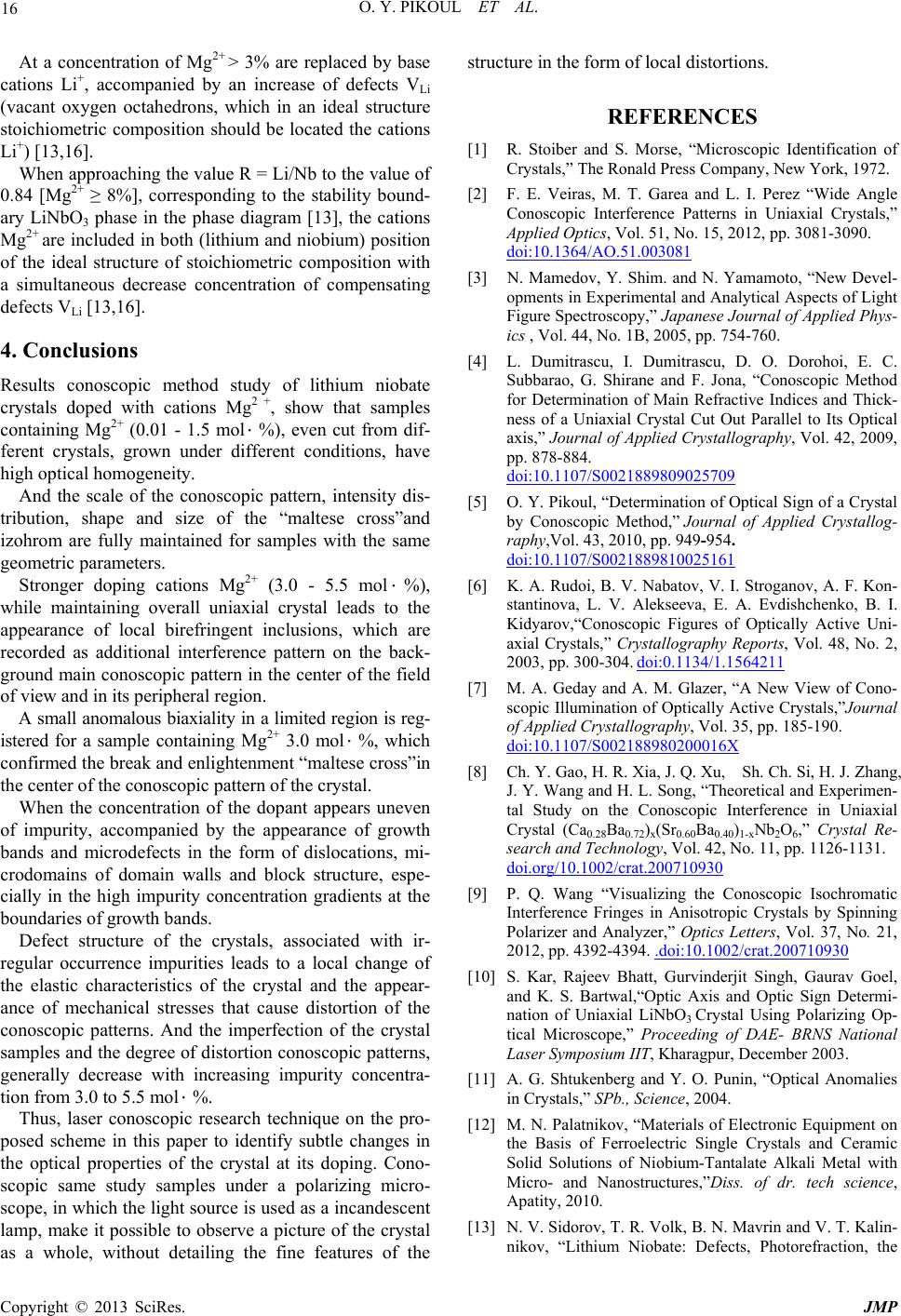
O. Y. PIKOUL ET AL.
16
At a concentration of Mg2+ > 3% are replaced by base
cations Li+, accompanied by an increase of defects VLi
(vacant oxygen octahedrons, which in an ideal structure
stoichiometric composition should be located the cations
Li+) [13,16].
When approaching the value R = Li/Nb to the value of
0.84 [Mg2+ ≥ 8%], corresponding to the stability bound-
ary LiNbO3 phase in the phase diagram [13], the cations
Mg2+ are included in both (lithium and niobium) position
of the ideal structure of stoichiometric composition with
a simultaneous decrease concentration of compensating
defects VLi [13,16].
4. Conclusions
Results conoscopic method study of lithium niobate
crystals doped with cations Mg2 +, show that samples
containing Mg2+ (0.01 - 1.5 mol⋅%), even cut from dif-
ferent crystals, grown under different conditions, have
high optical homogeneity.
And the scale of the conoscopic pattern, intensity dis-
tribution, shape and size of the “maltese cross”and
izohrom are fully maintained for samples with the same
geometric parameters.
Stronger doping cations Mg2+ (3.0 - 5.5 mol%),
while maintaining overall uniaxial crystal leads to the
appearance of local birefringent inclusions, which are
recorded as additional interference pattern on the back-
ground main conoscopic pattern in the center of the field
of view and in its peripheral region.
⋅
A small anomalous biaxiality in a limited region is reg-
istered for a sample containing Mg2+ 3.0 mol⋅%, which
confirmed the break and enlightenment “maltese cross”in
the center of the conoscopic pattern of the crystal.
When the concentration of the dopant appears uneven
of impurity, accompanied by the appearance of growth
bands and microdefects in the form of dislocations, mi-
crodomains of domain walls and block structure, espe-
cially in the high impurity concentration gradients at the
boundaries of growth bands.
Defect structure of the crystals, associated with ir-
regular occurrence impurities leads to a local change of
the elastic characteristics of the crystal and the appear-
ance of mechanical stresses that cause distortion of the
conoscopic patterns. And the imperfection of the crystal
samples and the degree of distortion conoscopic patterns,
generally decrease with increasing impurity concentra-
tion from 3.0 to 5.5 mol⋅%.
Thus, laser conoscopic research technique on the pro-
posed scheme in this paper to identify subtle changes in
the optical properties of the crystal at its doping. Cono-
scopic same study samples under a polarizing micro-
scope, in which the light source is used as a incandescent
lamp, make it possible to observe a picture of the crystal
as a whole, without detailing the fine features of the
structure in the form of local distortions.
REFERENCES
[1] R. Stoiber and S. Morse, “Microscopic Identification of
Crystals,” The Ronald Press Company, New York, 1972.
[2] F. E. Veiras, M. T. Garea and L. I. Perez “Wide Angle
Conoscopic Interference Patterns in Uniaxial Crystals,”
Applied Optics, Vol. 51, No. 15, 2012, pp. 3081-3090.
doi:10.1364/AO.51.003081
[3] N. Mamedov, Y. Shim. and N. Yamamoto, “New Devel-
opments in Experimental and Analytical Aspects of Light
Figure Spectroscopy,” Japanese Journal of Applied Phys-
ics , Vol. 44, No. 1B, 2005, pp. 754-760.
[4] L. Dumitrascu, I. Dumitrascu, D. O. Dorohoi, E. C.
Subbarao, G. Shirane and F. Jona, “Conoscopic Method
for Determination of Main Refractive Indices and Thick-
ness of a Uniaxial Crystal Cut Out Parallel to Its Optical
axis,” Journal of Applied Crystallography, Vol. 42, 2009,
pp. 878-884.
doi:10.1107/S0021889809025709
[5] O. Y. Pikoul, “Determination of Optical Sign of a Crystal
by Conoscopic Method,” Journal of Applied Crystallog-
raphy,Vol. 43, 2010, pp. 949-954.
doi:10.1107/S0021889810025161
[6] K. A. Rudoi, B. V. Nabatov, V. I. Stroganov, A. F. Kon-
stantinova, L. V. Alekseeva, E. A. Evdishchenko, B. I.
Kidyarov,“Conoscopic Figures of Optically Active Uni-
axial Crystals,” Crystallography Reports, Vol. 48, No. 2,
2003, pp. 300-304. doi:0.1134/1.1564211
[7] M. A. Geday and A. M. Glazer, “A New View of Cono-
scopic Illumination of Optically Active Crystals,”Journal
of Applied Crystallography, Vol. 35, pp. 185-190.
doi:10.1107/S002188980200016X
[8] Ch. Y. Gao, H. R. Xia, J. Q. Xu, Sh. Ch. Si, H. J. Zhang,
J. Y. Wang and H. L. Song, “Theoretical and Experimen-
tal Study on the Conoscopic Interference in Uniaxial
Crystal (Ca0.28Ba0.72)x(Sr0.60Ba0.40)1-xNb2O6,” Crystal Re-
search and Technology, Vol. 42, No. 11, pp. 1126-1131.
doi.org/10.1002/crat.200710930
[9] P. Q. Wang “Visualizing the Conoscopic Isochromatic
Interference Fringes in Anisotropic Crystals by Spinning
Polarizer and Analyzer,” Optics Letters, Vol. 37, No. 21,
2012, pp. 4392-4394. .doi:10.1002/crat.200710930
[10] S. Kar, Rajeev Bhatt, Gurvinderjit Singh, Gaurav Goel,
and K. S. Bartwal,“Optic Axis and Optic Sign Determi-
nation of Uniaxial LiNbO3 Crystal Using Polarizing Op-
tical Microscope,” Proceeding of DAE- BRNS National
Laser Symposium IIT, Kharagpur, December 2003.
[11] A. G. Shtukenberg and Y. O. Punin, “Optical Anomalies
in Crystals,” SPb., Science, 2004.
[12] M. N. Palatnikov, “Materials of Electronic Equipment on
the Basis of Ferroelectric Single Crystals and Ceramic
Solid Solutions of Niobium-Tantalate Alkali Metal with
Micro- and Nanostructures,”Diss. of dr. tech science,
Apatity, 2010.
[13] N. V. Sidorov, T. R. Volk, B. N. Mavrin and V. T. Kalin-
nikov, “Lithium Niobate: Defects, Photorefraction, the
Copyright © 2013 SciRes. JMP